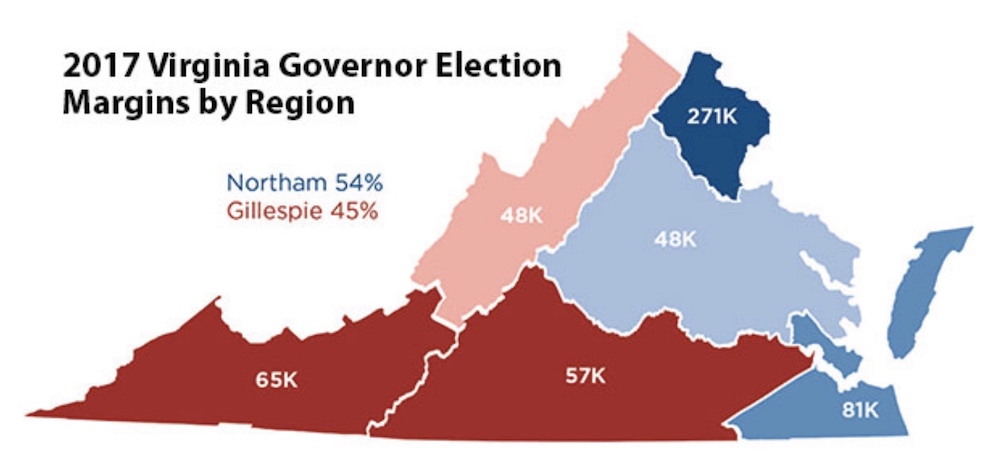While Democratic leader in the Virginia House of Delegates, I witnessed Terry McAuliffe’s lead in the 2013 governor’s race collapse in the aftermath of the botched rollout of the federal health care exchanges. He won, but only because the campaign ended before the full force of the public’s anger could be felt.
Four years later, in 2017, it was the Republicans turn to feel the cold wind blowing from DC, as strong anti-Trump sentiment not only vanquished the GOP candidate and produced Governor Ralph Northam’s 9-point victory but brought Democrats within a coin toss of parity in the House of Delegates.

Hence, it should surprise few that Washington politics should extract a toll on the Commonwealth, helping to propel Republican Glenn Youngkin to a narrow victory in the Governor’s race and allowing Republicans to retake the majority in the House of Delegates that they had lost two years ago. State elections are increasingly impacted by national trends—and Virginia feels it more than most.
Elections typically turn on factors that by themselves are not determinative but make the difference in combination. The Washington mood, controversy in the schools, Republican enthusiasm, McAuliffe’s “gaffe,” a decline in the COVID infections, and the effectiveness of Youngkin’s campaign were all part of the explanation for the GOP victory. The Republican decision to nominate their candidate by a “ranked choice voting” system appeared chaotic at the time but had the effect of preventing Trump-acolyte Amanda Chase from winning their nomination. And give the GOP credit for an effective turnout effort. Democratic turnout greatly exceeded 2017 levels and would have generated a win in most years. But it was swamped by record GOP numbers.

As Democrats scramble to learn the lessons of the recent performance, here are a few to consider:
- State policies matter—so talk about them. Virginia Democrats pushed and passed popular initiatives—Medicaid expansion, the ERA, minimum wage increases, gun safety measures, and, despite the rhetoric of “defund the police,” enhanced funding for law enforcement. Somehow, these got lost. Former Governor McAuliffe started his campaign heralding his bold plan for historic investments in education. That too was lost, as the campaign appeared overly fixated on Trump and his politics of division. Some voters did not focus on what Democrats were doing in Richmond—and were not sure what could happen in another McAuliffe administration. Others were angry with what Democrats were not doing in Washington. They cared little for internecine party scrabbles between progressives and moderates. They wanted results. And they were not getting them from DC. Democrats took the blame, not just in Virginia, but in New Jersey as well.
- Schools and parents matter. Mr. Youngkin seized on Mr. McAuliffe’s remark that he didn’t “believe parents should be telling schools what they should teach,” and used it to undermine the former governor’s promise to make “historic” investments in education and teacher salaries. Into the fall, polls showed a significant increase in the percentage of voters who viewed education as their top issue, rising from 15 percent in September to 24 percent in late October. Election-day exit polling reported that a supermajority of Virginia voters believed parents should have a voice in what schools teach their children. Youngkin’s positioning on the issue undermined a key element of the Democratic coalition — suburban women. Two counties where Democrats had gained substantially in recent years illustrate the change. In Loudoun County, McAuliffe’s 11-point win paled in comparison to Biden’s 25-point margin a year ago. Similarly, Democrats won Chesterfield by 7 points in 2020, only to lose it by 11 this year. Finally, McAuliffe dramatically underperformed with women. Biden captured this key constituency by 23 points, but exit polls indicated that McAuliffe won the group by only six. Education, a uniquely state issue where Democrats had dominated, had been turned against them.
- We remain divided into our respective political tribes. There was little ticket-splitting in Virginia, and that resulted in Democratic losses in close races up and down the ticket. Even with the massive Republican turnout, a swing of several hundred votes in three House races would have preserved Democratic control of that body. Youngkin’s victory was neither a landslide nor a mandate. If it had occurred 10 years ago, it would have appeared to be just another Republican win. But the formerly reliable red state has changed in the last two decades — and a GOP win is therefore perceived as a disruptive outlier.
- Voting rights matter. Virginia democrats made voting much easier, instituting no-excuse early voting for 45 days prior to the election. It is one reason why the Commonwealth saw the largest turnout for a governor’s race in recent history — by a lot. Much of the early vote came from reliably red areas across the state. Even as McAuliffe won 600,000 more votes than in 2013 and 200,000 more than Northam’s total in 2017, Republican turnout overwhelmed the Democrats, especially in traditionally red areas, where some increases were greater than 40 percent. Interestingly, a similar dynamic occurred in New Jersey, where turnout in Democratic counties increased in the governor’s race by about 13% from 2017 but Republican increases were huge, jumping 36 percent from four years ago.
- Diversity is not Destiny. The change in the demographic mix in Virginia has been thought to be a major cause of Democratic victories in 14 of the last 21 statewide elections, wins in every presidential contest since Obama in 2008, and the election of two Democratic U.S. Senators. But this year, it was not decisive. Youngkin made inroads in the African American and Hispanic communities. Moreover, the electorate included more white voters than 2020. White Virginians accounted for 74 percent of voters, up from 67 percent last year. And a majority of them voted for Youngkin.
- Trump was a factor, but not in the way that was expected. Youngkin was masterful in saying enough to mobilize Trump voters while avoiding direct links to the former President. McAuliffe’s constant references to Trump may have motivated some voters to reprise their 2020 vote, but each election, especially in the states, is unique. By 2021, some of the anti-Trump energy so critical to the success of Virginia Democrats in 2019 and 2020 had dissipated, and McAuliffe’s efforts to link his opponent to the former President may have unintentionally fueled a perception that he was the divisive candidate who had little to say about state issues. In fact, exit polls showed that independents, many of whom remain extremely uncomfortable with Trump, broke for Youngkin.
If Virginia is a bellwether of political trends in the nation, this election illustrates that many Virginians were ready to move on from Trump. The former President attempted to take credit for the GOP wins, but there is little evidence of it.
Despite concerns that a Republican governorship will mean the rollback of key Democratic initiatives, the Senate, barring death or defection, remains under Democratic control until at least 2023. That should prevent the Commonwealth from moving too quickly in a conservative direction. But the Governor’s powers are extensive, and his ability to bring change, either through appointments, executive action, or the budget cannot be overlooked. The next few years will show the degree to which the new Governor will embrace policies pleasing to Trump and his base. And the state will again take center stage in helping determine the direction of the nation.

